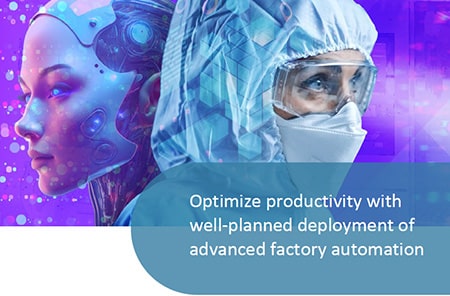Part 2: Fly.
The MES ideally provides everything needed to automate steady-state manufacturing. But in the ‘lights out’ factory, all forms of non-standard processing need to be automated, as well. In Part 2 of this multi-part series, we’ll look at some of the enhanced capabilities that can be integrated with the MES to provide manufacturing intelligence that leads us closer to the ideal of the ‘lights out’ factory.
Transcript
In part one, we used the metaphor crawl, walk, run to describe how the needs of a factory evolve over time. But that metaphor doesn’t get us quite as far as we need to go to that apex of manufacturing efficiency, the lights-out factory. So let’s extend the crawl, walk, run metaphor to include fly.
Fly is the lights-out factory, or at least something approaching that. Everything within this factory is fully configured and automated. Process definitions, tool control, optimized production scheduling, product movement throughout the factory, data collection, and specifications validation.
But that’s only what’s required for standard steady-state processing. Non-standard processing also needs to be automated. What happens when product measurements are out of spec? Can the product be reworked, or does it need to be scrapped? Is this a one-off event, or is it a systemic issue? How do we prevent this from happening to follow on product, and how do we identify and correct the root cause? And what about non-product processing? How do we automate processing for maintenance and qualifications, or engineering experiments, or R&D process development? In the lights-out factory, not only does non-product processing need to be automated, but also the response to that processing, such as what to do when a tool qualification fails.
FLY is where intelligence becomes necessary. If we can use SPC charts to detect when a process is going out of control, we should be able to use that data to intelligently and automatically tune the process recipe for relevant upstream process tools. If a process tool goes out of service unexpectedly, we should be able to intelligently reschedule product to run on other qualified tools to prevent excessive delays in late product shipments.
If a defect is detected on product in a manufacturing line where, say, only one in 10 lots is inspected, we should be able to intelligently determine the source of the defect, then identify the lots processed on either side of the initial problem lot, and automatically inspect them too. Intelligence allows us to dynamically automate the things that can’t be planned and coordinated in advance. Let’s step back for a moment and recall a rather dated term, computer integrated manufacturing, or CIM.
The notion of computer integrated manufacturing was introduced in a 1974 book of the same name by Joseph Harrington, back before computers were widely available in manufacturing, or anywhere else for that matter. In its highest form, computer integrated manufacturing envisioned what we now call the lights-out factory. The key attribute of the CIM system is that it should control every part of the production process.
That’s a much larger scope than how we’ve defined the modest capabilities of the MES. And yet, it leaves a lot of room for how additional capabilities can be layered onto the MES to create a total manufacturing solution. It also leaves a lot of flexibility for how to eventually get to the lights-out factory, even if you’re starting as a small manufacturer that does everything by hand.
Clearly, the MES is at the heart of the CIM, its foundation. A properly configured MES defines and coordinates all processing within even the most basic manufacturing. Additional capabilities can be added to and integrated with the MES over time to enable richer functionality in the CIM system as a manufacturer’s needs evolve.
However, integrating additional functionality within the MES is not a trivial task. Integration is the key word. Each piece of functionality added has its own unique integration requirements.
These glue layers are necessary to make the pieces within the CIM act as an integrated system. But these glue layers are difficult, time-consuming, and costly to implement. That is, unless you have a CIM system that provides the functionality you need pre-integrated. Ideally, you also want a path forward to add additional capabilities as your manufacturing needs grow all the way to the lights-out factory, and all pre-integrated without the need to implement custom glue layers.
The Applied SmartFactory CIM provides just such a solution. Start with the SmartFactory MES to get your factory up and running at the crawl stage. Then, when your factory is ready to walk, add tool automation, data collection, and runtime spec validation, along with SPC for process monitoring.
When your factory is ready to run, add the material control system to coordinate automated product movement throughout the factory, and production scheduling and dispatching to optimize the product flow. Finally, when your factory is ready to fly, add run-to-run control to dynamically tune process recipes based on metrology results, and build machine learning models for artificial intelligence systems to improve defect detection and product yield. Everything is pre-integrated, so no glue layers to implement, just configurations to tailor the systems for how your factory works.
In Part 3, we’ll rewind to take a look at a hypothetical factory at the crawl stage, and look at how the MES is the key system to define and control manufacturing, and at the heart of the CIM. Then we’ll fast forward a bit and look at some of the CIM capabilities that allow our hypothetical factory to walk.


